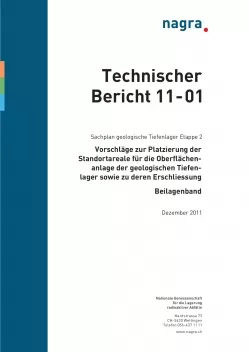
Technischer Bericht NTB 11-01
Vorschläge zur Platzierung der Standortareale für die Oberflächenanlage der geologischen Tiefenlager sowie zu deren Erschliessung
In line with the provisions of the nuclear energy legislation, the sites for deep geological disposal of Swiss radioactive waste are selected in a three-stage Sectoral Plan process (Sectoral Plan for Deep Geological Repositories). The disposal sites are specified in Stage 3 of the selection process with the granting of a general licence in accordance with the Nuclear Energy Act.
The first stage of the process was completed on 30th November 2011, with the decision of the Federal Council to incorporate the six geological siting regions proposed by the National Cooperative for the Disposal of Radioactive Waste (Nagra) into the Sectoral Plan for Deep Geological Repositories for further evaluation in Stage 2. The decision also specifies the planning perimeters within which the surface facilities and shaft locations for the repositories will be constructed.
In the second stage of the process, at least two geological siting regions each will be specified for the repository for low- and intermediate-level waste (L/ILW) and for the high-level waste (HLW) repository and these will undergo detailed geological investigation in Stage 3. For each of these potential siting regions, at least one location for the surface facility and a corridor for the access infrastructure will also be specified.
Nagra is responsible, at the beginning of Stage 2, for submitting proposals for potential locations for the surface facilities and their access infrastructure to the Federal Office of Energy (SFOE); these are then considered by the regional participation bodies in the siting regions. The present report and its appendices volume document these proposals. In Stage 2, under the lead of the SFOE, socio-economic-ecological studies will also be carried out to investigate the impact of a repository project on the environment, economy and society. The present reports also contain the input data to be provided by Nagra for the generic (site-independent) part of these impact studies.
A meaningful discussion of the proposals made by Nagra (cf. appendices volume) requires an understanding of the functioning of the components of the repository, supported by relevant basic data. This general report, which is independent of the proposed siting regions, provides an overview of the facilities and their functioning for both the L/ILW and the HLW repositories, the operating procedures and the impacts associated with construction and operation. The report
- summarises the legal framework and the waste management programme and recaps the result of Stage 1 of the siting process; the waste management programme sets out the individual work steps leading to geological disposal of radioactive waste,
- provides a generic description of the function of the geological repositories and the components of the entire facility, to allow a general understanding of the surface facility and its access infrastructure,
- describes the surface infrastructure, particularly the different components of the surface facility for both the L/ILW and HLW repositories, as well as for a combined repository for co-disposal of L/ILW and HLW (in which the spatially separated underground installations for HLW and L/ILW are accessed from a common surface facility),
- outlines the general possibilities for configuring the surface facility and its access using the existing transport network (road, rail),
- provides background information as a basis for discussing the possible effects of a repository at the surface during construction and operation at the siting location,
The appendices volume contains the proposals made by Nagra for the siting areas for the surface facilities within the six potential planning perimeters and how these will be developed and accessed. Following a general overview and brief presentation of the siting regions, the individual proposals for the locating the siting areas for the surface facilities are presented in fact-sheets.
These fact-sheets consist of presentations of the geographic situation together with a brief description of the siting areas using a uniform list of criteria and indicators. These criteria and indicators are also applied for the selection and characterisation of the siting areas, with the following overarching objectives:
- safety and technical/engineering feasibility
- spatial planning and environmental compatibility
- local integration in the region
The proposals for siting areas for the surface facilities should serve, in the first instance, as the basis for discussions between the siting regions and Nagra. In order to secure their interests, it is important that the siting regions should be in a position to make use of the available flexibility in the process. They can also put forward their own proposals as part of this collaboration.
- presents the criteria and indicators used by Nagra for making the proposals for the selection of the locations for the surface facility within the planning perimeters and
- presents the input data provided by Nagra for the generic section of the socio-economic-ecological impact studies (economy). In the case where the input data differ for the individual siting regions, the information is presented in the appendices volume (excavated rock volumes).
